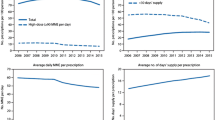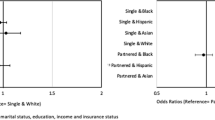Abstract
Background
The opioid epidemic is an escalating health crisis. We evaluated the impact of opioid prescription rates and socioeconomic determinants on opioid mortality rates, and identified potential differences in prescription patterns by categories of practitioners.
Methods
We combined the 2013 and 2014 Medicare Part D data and quantified the opioid prescription rate in a county level cross-sectional study with data from 2710 counties, 468,614 unique prescribers and 46,665,037 beneficiaries. We used the CDC WONDER database to obtain opioid-related mortality data. Socioeconomic characteristics for each county were acquired from the US Census Bureau.
Results
The average national opioid prescription rate was 3.86 claims per beneficiary that received a prescription for opioids (95% CI 3.86–3.86). At a county level, overall opioid prescription rates (p < 0.001, Coeff = 0.27) and especially those provided by emergency medicine (p < 0.001, Coeff = 0.21), family medicine physicians (p = 0.11, Coeff = 0.008), internal medicine (p = 0.018, Coeff = 0.1) and physician assistants (p = 0.021, Coeff = 0.08) were associated with opioid-related mortality. Demographic factors, such as proportion of white (p white < 0.001, Coeff = 0.22), black (p black < 0.001, Coeff = − 0.19) and male population (p male < 0.001, Coeff = 0.13) were associated with opioid prescription rates, while poverty (p < 0.001, Coeff = 0.41) and proportion of white population (p white < 0.001, Coeff = 0.27) were risk factors for opioid-related mortality (p model < 0.001, R 2 = 0.35). Notably, the impact of prescribers in the upper quartile was associated with opioid mortality (p < 0.001, Coeff = 0.14) and was twice that of the remaining 75% of prescribers together (p < 0.001, Coeff = 0.07) (p model = 0.03, R 2 = 0.03).
Conclusions
The prescription opioid rate, and especially that by certain categories of prescribers, correlated with opioid-related mortality. Interventions should prioritize providers that have a disproportionate impact and those that care for populations with socioeconomic factors that place them at higher risk.


Similar content being viewed by others
References
Constantino T. IMS Health Study: U.S. Drug Spending Growth Reaches 8.5 Percent in 2015. 2016. http://www.imshealth.com/en/about-us/news/ims-health-study-us-drug-spending-growth-reaches-8.5-percent-in-2015.
Statistics CfDCaPNCfH. Multiple Cause of Death 1999–2014 on CDC WONDER Online Database, released 2015. 2016. http://wonder.cdc.gov/mcd-icd10.html.
Rudd RA, Seth P, David F, Scholl L. Increases in drug and opioid-involved overdose deaths—United States, 2010–2015. MMWR Morb Mortal Wkly Rep. 2016;65(5051):1445–52.
King NB, Fraser V. Untreated pain, narcotics regulation, and global health ideologies. PLoS Med. 2013;10(4):e1001411.
Hawton K, Bergen H, Simkin S, Wells C, Kapur N, Gunnell D. Six-year follow-up of impact of co-proxamol withdrawal in England and Wales on prescribing and deaths: time-series study. PLoS Med. 2012;9(5):e1001213.
Johnson H, Paulozzi L, Porucznik C, Mack K, Herter B. Decline in drug overdose deaths after state policy changes—Florida, 2010–2012. MMWR Morb Mortal Wkly Rep. 2014;63(26):569–74.
Ringwalt C, Gugelmann H, Garrettson M, Dasgupta N, Chung AE, Proescholdbell SK, et al. Differential prescribing of opioid analgesics according to physician specialty for Medicaid patients with chronic noncancer pain diagnoses. Pain Res Manag J Can Pain Soc. 2014;19(4):179–85.
Chen JH, Humphreys K, Shah NH, Lembke A. Distribution of opioids by different types of medicare prescribers. JAMA Int Med. 2016;176(2):259–61.
Medicare. Medicare part D opioid prescriber summary file. 2016. https://www.cms.gov/Research-Statistics-Data-and-Systems/Statistics-Trends-and-Reports/Medicare-Provider-Charge-Data/OpioidMap.html.
Klees BSWCJ. Brief summaries of Medicare & Medicaid 2013. https://www.cms.gov/Research-Statistics-Data-and-Systems/Statistics-Trends-and-Reports/MedicareProgramRatesStats/Downloads/MedicareMedicaidSummaries2013.pdf.
Bureau USC. 2010 ZIP code tabulation area (ZCTA) relationship files. https://www.census.gov/geo/maps-data/data/zcta_rel_download.html.
Bureau USC. American FactFinder. http://factfinder2.census.gov/.
Bureau USC. When to use 1-year, 3-year, or 5-year estimates American Community Survey (ACS) [updated 6 Sep 2016, 18 July 2016]. http://www.census.gov/programs-surveys/acs/guidance/estimates.html.
Belsley DA, Kuh E, Welsch RE. Detecting and assessing collinearity. Regression diagnostics. Hoboken: John Wiley & Sons, Inc.; 2005. p. 85–191.
Open Source Geospatial Foundation Project 2016. Updated 5 Nov. http://www.qgis.org/en/site/.
Popovich N. A deadly crisis: mapping the spread of America’s drug overdose epidemic: the Guardian. 2016. https://www.theguardian.com/society/ng-interactive/2016/may/25/opioid-epidemic-overdose-deaths-map.
Olsen Y. The CDC guideline on opioid prescribing: rising to the challenge. JAMA. 2016;315(15):1577–9.
Goldenbaum DM, Christopher M, Gallagher RM, Fishman S, Payne R, Joranson D, et al. Physicians charged with opioid analgesic-prescribing offenses. Pain Med (Malden, Mass.). 2008;9(6):737–47.
Dowell D, Haegerich TM, Chou R. CDc guideline for prescribing opioids for chronic pain—united states, 2016. JAMA. 2016;315(15):1624–45.
Dowell D, Haegerich TM, Chou R. CDC guideline for prescribing opioids for chronic pain—United States, 2016. MMWR Recomm Rep Morb Mortal Wkly Rep Recomm Rep. 2016;65(1):1–49.
Bernstein L. Aetna is notifying some doctors about their drug-dispensing habits. The Washington Post. https://www.washingtonpost.com/news/to-your-health/wp/2016/08/03/aetna-is-notifying-some-doctors-about-their-drug-dispensing-habits/?utm_term=.52929125f028.
Barnett ML, Olenski AR, Jena AB. Opioid-prescribing patterns of emergency physicians and risk of long-term use. N Engl J Med. 2017;376(7):663–73.
Kolata G, Cohen S. Drug overdoses proper rise in mortality rates of young Whites. The New York Times. 2016. [updated 16 Jan 2016]. http://www.nytimes.com/2016/01/17/science/drug-overdoses-propel-rise-in-mortality-rates-of-young-whites.html?_r=0.
Becker WC, Starrels JL, Heo M, Li X, Weiner MG, Turner BJ. Racial differences in primary care opioid risk reduction strategies. Ann Fam Med. 2011;9(3):219–25.
Cerda M, Ransome Y, Keyes KM, Koenen KC, Tracy M, Tardiff KJ, et al. Prescription opioid mortality trends in New York City, 1990–2006: examining the emergence of an epidemic. Drug Alcohol Depend. 2013;132(1–2):53–62.
Gale JA, Schmitz D, Meit M, et al. Rural communities in crisis: strategies to address the opioid crisis 2016. [updated April 2016]. http://www.ruralhealthweb.org/index.cfm?objectid=DB1783C2-DB37-0073-AE5A339A5336A09E.
Mack KA, Zhang K, Paulozzi L, Jones C. Prescription practices involving opioid analgesics among Americans with Medicaid, 2010. J Health Care Poor Underserved. 2015;26(1):182–98.
CDC. Opioid painkiller prescribing 2016 [updated 1 July 2014]. http://www.cdc.gov/vitalsigns/opioid-prescribing/.
SERVICES USDOHAH. 2014 CMS statistics 2014. https://www.cms.gov/Research-Statistics-Data-and-Systems/Statistics-Trends-and-Reports/CMS-Statistics-Reference-Booklet/Downloads/CMS_Stats_2014_final.pdf.
Author information
Authors and Affiliations
Contributions
Guarantor of the article: CAG and EM accept full responsibility for the conduct of the study, have access to the data and have control of the decision to publish.
CAG and EM had full access to all of the data in the study and take responsibility for the integrity of the data and the accuracy of the data analysis. CAG: conceptualized and designed the study, performed the literature search, participated in data collection, extraction and interpretation, prepared tables and figures, performed the statistical analysis, drafted the initial manuscript, approved the final manuscript as submitted and agreed to be accountable for all aspects of the work in ensuring that questions related to the accuracy or integrity of any part of the work are appropriately investigated and resolved. SK: conceptualized and designed the study, performed the literature search, participated in data collection, extraction and interpretation, prepared tables and figures, performed the statistical analysis, wrote and drafted the initial manuscript, approved the final manuscript as submitted and agreed to be accountable for all aspects of the work in ensuring that questions related to the accuracy or integrity of any part of the work are appropriately investigated and resolved. EV: participated in literature search, participated in data collection, extraction and interpretation, reviewed and revised the manuscript, approved the final manuscript as submitted and agreed to be accountable for all aspects of the work in ensuring that questions related to the accuracy or integrity of any part of the work are appropriately investigated and resolved. MA: participated in literature search, reviewed and revised the manuscript, approved the final manuscript as submitted, and agreed to be accountable for all aspects of the work in ensuring that questions related to the accuracy or integrity of any part of the work are appropriately investigated and resolved. MEF: participated in literature search, reviewed and revised the manuscript, approved the final manuscript as submitted, and agreed to be accountable for all aspects of the work in ensuring that questions related to the accuracy or integrity of any part of the work are appropriately investigated and resolved. CKR: assisted in designing parts of the study, performed the literature search, participated in data collection, extraction and interpretation, reviewed and revised the manuscript, approved the final manuscript as submitted and agreed to be accountable for all aspects of the work in ensuring that questions related to the accuracy or integrity of any part of the work are appropriately investigated and resolved. INE: assisted in designing parts of the study, performed the literature search, participated in data collection, extraction and interpretation, reviewed and revised the manuscript, approved the final manuscript as submitted and agreed to be accountable for all aspects of the work in ensuring that questions related to the accuracy or integrity of any part of the work are appropriately investigated and resolved. PA: assisted in designing parts of the study, interpreted the data, prepared tables and figures, performed the statistical analysis, reviewed and revised the manuscript, approved the final manuscript as submitted and agreed to be accountable for all aspects of the work in ensuring that questions related to the accuracy or integrity of any part of the work are appropriately investigated and resolved. CIS: conceptualized and designed the study, interpreted the data, reviewed and revised the manuscript, approved the final manuscript as submitted and agreed to be accountable for all aspects of the work in ensuring that questions related to the accuracy or integrity of any part of the work are appropriately investigated and resolved. EM: Mylonakis conceptualized and designed the study, interpreted the data, reviewed and revised the manuscript, approved the final manuscript as submitted and agreed to be accountable for all aspects of the work in ensuring that questions related to the accuracy or integrity of any part of the work are appropriately investigated and resolved.
Corresponding author
Ethics declarations
Conflict of interest
All authors [CAG, SK, EV, MA, MEF, CKR, INE, PA, EM] declare no competing interests
Funding
None.
Ethical approval and informed consent
N/A.
Electronic supplementary material
Below is the link to the electronic supplementary material.
Rights and permissions
About this article
Cite this article
Grigoras, C.A., Karanika, S., Velmahos, E. et al. Correlation of Opioid Mortality with Prescriptions and Social Determinants: A Cross-sectional Study of Medicare Enrollees. Drugs 78, 111–121 (2018). https://doi.org/10.1007/s40265-017-0846-6
Published:
Issue Date:
DOI: https://doi.org/10.1007/s40265-017-0846-6




